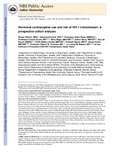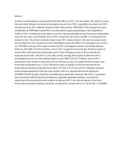| dc.contributor.author | Heffron, R | |
| dc.contributor.author | Donnell, D | |
| dc.contributor.author | Rees, H | |
| dc.contributor.author | Celum, C | |
| dc.contributor.author | Mugo N, de Bruyn G, Nakku-Joloba E Were E | |
| dc.contributor.author | Ngure K, Coombs RW, Baeten JM Kiarie J, | |
| dc.date.accessioned | 2013-06-12T12:48:34Z | |
| dc.date.available | 2013-06-12T12:48:34Z | |
| dc.date.issued | 2012 | |
| dc.identifier.citation | . Use of hormonal contraceptives and risk of HIV-1 transmission: a prospective cohort study. Heffron R, Donnell D, Rees H, Celum C, Mugo N, Were E, de Bruyn G, Nakku-Joloba E, Ngure K, Kiarie J, Coombs RW, Baeten JM; Partners in Prevention HSV/HIV Transmission Study Team. Lancet Infect Dis. 2012 Jan;12(1):19-26. doi: 10.1016/S1473-3099(11)70247-X. Epub 2011 Oct 3. Erratum in: Lancet Infect Dis. 2012 Feb;12(2):98. | en |
| dc.identifier.uri | http://www.ncbi.nlm.nih.gov/pubmed/21975269 | |
| dc.identifier.uri | http://erepository.uonbi.ac.ke:8080/xmlui/handle/123456789/32340 | |
| dc.identifier.uri | http://www.ncbi.nlm.nih.gov/pmc/articles/PMC3266951/ | |
| dc.identifier.uri | | |
| dc.description.abstract | Hormonal contraceptives are used widely but their effects on HIV-1 risk are unclear. We aimed to assess the association between hormonal contraceptive use and risk of HIV-1 acquisition by women and HIV-1 transmission from HIV-1-infected women to their male partners.
METHODS:
In this prospective study, we followed up 3790 heterosexual HIV-1-serodiscordant couples participating in two longitudinal studies of HIV-1 incidence in seven African countries. Among injectable and oral hormonal contraceptive users and non-users, we compared rates of HIV-1 acquisition by women and HIV-1 transmission from women to men. The primary outcome measure was HIV-1 seroconversion. We used Cox proportional hazards regression and marginal structural modelling to assess the effect of contraceptive use on HIV-1 risk.
FINDINGS:
Among 1314 couples in which the HIV-1-seronegative partner was female (median follow-up 18·0 [IQR 12·6-24·2] months), rates of HIV-1 acquisition were 6·61 per 100 person-years in women who used hormonal contraception and 3·78 per 100 person-years in those who did not (adjusted hazard ratio 1·98, 95% CI 1·06-3·68, p=0·03). Among 2476 couples in which the HIV-1-seronegative partner was male (median follow-up 18·7 [IQR 12·8-24·2] months), rates of HIV-1 transmission from women to men were 2·61 per 100 person-years in couples in which women used hormonal contraception and 1·51 per 100 person-years in couples in which women did not use hormonal contraception (adjusted hazard ratio 1·97, 95% CI 1·12-3·45, p=0·02). Marginal structural model analyses generated much the same results to the Cox proportional hazards regression.
INTERPRETATION:
Women should be counselled about potentially increased risk of HIV-1 acquisition and transmission with hormonal contraception, especially injectable methods, and about the importance of dual protection with condoms to decrease HIV-1 risk. Non-hormonal or low-dose hormonal contraceptive methods should be considered for women with or at-risk for HIV-1.
FUNDING: | en |
| dc.title | Use of hormonal contraceptives and risk of HIV-1 transmission: a prospective cohort study. | en |
| dc.type | Article | en |
| local.publisher | Epidemiology, University of Washington, Seattle, WA, USA. | en |


